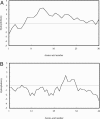Bacteriocin T8, a novel class IIa sec-dependent bacteriocin produced by Enterococcus faecium T8, isolated from vaginal secretions of children infected with human immunodeficiency virus
- PMID: 16820469
- PMCID: PMC1489345
- DOI: 10.1128/AEM.00436-06
Bacteriocin T8, a novel class IIa sec-dependent bacteriocin produced by Enterococcus faecium T8, isolated from vaginal secretions of children infected with human immunodeficiency virus
Abstract
Enterococcus faecium T8, isolated from vaginal secretions of children with human immunodeficiency virus, produces a class IIa sec-dependent bacteriocin that is structurally different from three other class IIa sec-dependent bacteriocins, i.e., enterocin P and an enterocin P-like bacteriocin, produced by Enterococcus faecium, and bacteriocin 31, produced by Enterococcus faecalis, and from a class III bacteriocin produced by E. faecalis. The genes encoding the bacteriocin, immunity protein, mobilization protein, and relaxase nuclease are located on a 7-kb plasmid. Bacteriocin T8 has a molecular mass of 5.1 kDa based on its DNA sequence, similar to the 5.0 kDa recorded for bacteriocin 31 but larger than the 4.6 kDa reported for enterocin P. At the amino acid level, bacteriocin T8 is 69% homologous to bacteriocin 31 and 47% homologous to enterocin P. Bacteriocin T8 is active against E. faecalis isolated from patients diagnosed with vaginosis, against Lactobacillus sakei, and against a Propionibacterium sp. The peptide is heat stable (60 min at 100 degrees C) and remains active in phosphate buffer from pH 4.0 to 10.0. The mode of activity is bactericidal, as determined with E. faecalis.
Figures




References
-
- Ausubel, F. M., R. Brent, R. E. Kingston, D. D. Moore, J. G. Seidman, J. A. Smith, and K. Struhl. 1994. Current protocols in molecular microbiology. John Wiley and Sons, Inc., New York, N.Y.
-
- Balla, E., and L. M. Dicks. 2005. Molecular analysis of the gene clusters involved in the production and secretion of enterocins 1071A and 1071B and the genes responsible for the replication and transfer of plasmid pEF1071. Int. J. Food Microbiol. 99:33-45. - PubMed
Publication types
MeSH terms
Substances
Associated data
- Actions
LinkOut - more resources
Full Text Sources
Molecular Biology Databases

